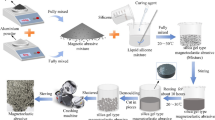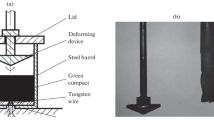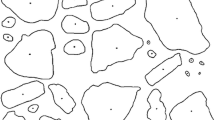Abstract
Magnetic elastic abrasive particles are a new type of particle that combines the characteristics of magnetic abrasive particles and elastic abrasive particles by embedding magnetic media and abrasive particles in a specific proportion into a flexible polymer to create particles with a specific shape. The magneto-elastic abrasive particles were prepared using liquid silica gel as the matrix, alumina particles (Al2O3) or silicon carbide particles (SiC) as the abrasive phase, and iron particles as the magnetic particle phase. A representative microunit model of magnetic elastic abrasive particles is created using 3DMAX software. The finite element software ABAQUS analyzes the micromechanical properties of magnetic elastic abrasive particles with silicon carbide (SiC) and alumina (Al2O3) particles as the abrasive phase, respectively. Secondly, based on the characteristics of double-disk magnetic force passivation of magnetic elastic abrasive particles, a method is proposed to predict the life of magnetic elastic abrasive particles by predicting the roughness of the tool edge. The impact of particle size and abrasive phase on the wear and life of magnetic elastic abrasive particles is studied experimentally. Finally, the magnetic field force is analyzed and a mathematical model for material removal for magnetic elastic abrasive particles is established based on the mixing phase’s characteristics. The effects of particle size and abrasive degree on material removal volume and the influence of magnetic elastic abrasive particle size on tool passivation are studied experimentally. A comparison is made with the vertical rotary passivation method. The superiority of the magnetic flexible abrasive particle passivation method is confirmed by examining the passivated tool’s edge profile, surface roughness, and service life.































Similar content being viewed by others
References
Wang DL, Li XH, Li WH, Yang SQ (2018) Preparation of viscoelastic magnetic abrasive tool based on 107 silicone rubber and experimental study. Surface Technology. Surface Technology 047(006):258–264. https://doi.org/10.16490/j.cnki.issn.1001-3660.2018.06.037
Zhao YG, Wang SJ, Zhao GY (2002) Application and development of magnetic grain finishing technology. J Shandong Inst Technol 016(001):8–13
Wang AC, Cheng KC, Chen KY, Lin YC (2018) A study on the abrasive gels and the application of abrasive flow machining in complex-hole polishing. Procedia Cirp 68:523–528. https://doi.org/10.1016/j.procir.2017.12.107
Yan BH, Chen WC, Wu KL (2014) A study on the application of newly developed magneto-elastic abrasive to improving the surface roughness of the bore. Int J Adv Manuf Technol 73:1557–1566. https://doi.org/10.1007/s00170-014-5942-0
Seyedi SS, Shabgard MR, Mousavi SB, Heris SZ (2021) The impact of SiC, Al2O3, and B2O3 abrasive particles and temperature on wear characteristics of 18Ni (300) maraging steel in abrasive flow machining (AFM). Int J Hydrogen Energy 6:33991–34001. https://doi.org/10.1016/j.ijhydene.2021.04.051
Liu G, Zhao Y, Meng J (2022) Preparation of Al2O3 magnetic abrasives by combining plasma molten metal powder with sprayed abrasive powder. Ceram Int 48:21571–21578
Yang B, Lu W, Feng W, Yang X, Zuo D (2016) Adsorption and deposition of micro diamond particles in preparing diamond magnetic abrasives by electroless composite plating. Diam Relat Mater 73:137–142. https://doi.org/10.1016/j.diamond.2016.08.015
Chen WC, Wu KL, Yan BH, Tsao MC (2013) A study on the magneto-assisted spiral polishing on the inner wall of the bore with magnetic hot melt adhesive particles (MHMA particles). Int J Adv Manuf Technol 69:1791–1801. https://doi.org/10.1007/s00170-013-5139-y
Chow HM, Yang LD, Chen YF, Huang YH, Lin YC (2014) Development on silicon rubber elastic composite magnetic abrasive and research on internal polishing. Appl Mech Mater 620:472–475. https://doi.org/10.4028/www.scientific.net/AMM.620.472
Preston FW (1927) The theory and design of plate glass finishing machines. Glass Technol 11:214
Li W, Li J, Cheng B, Zhang X, Song Q, Wang Y, Zhang T, Seniuts U, Belotsrkovsky M (2021) Achieving in-situ alloy-hardening core-shell structured carbonyl iron powders for magnetic abrasive finishing. Mater Des 212:110–198. https://doi.org/10.1016/j.matdes.2021.110198
Gao Y, Zhao Y, Zhang G (2018) Preparation of Al2O3 magnetic abrasives by gas-solid two-phase double-stage atomization and rapid solidification. Mater Lett 215:300–304
Schimmel RJ, Manjunathaiah J, Endres WJ (2000) Edge radius variability and force measurement considerations. J Manuf Sci Eng 122:590–593. https://doi.org/10.1115/1.1286255
Denkena B, Lucas A, Bassett E (2011) Effects of the cutting edge microgeometry on tool wear and its thermo mechanical load. CIRP Ann Manuf Technol 60:73–78. https://doi.org/10.1016/j.cirp.2011.03.098
Rech J, Yen YC, Schaff MJ, Hamdi H, Altan T, Bouzakis KD (2005) Influence of cutting edge radius on the wear resistance of PM-HSS milling inserts. Wear 259(7–12):1168–1176. https://doi.org/10.1016/j.wear.2005.02.072
Childs THC, Sekiya K, Tezuka R, Yamane Y, Dornfeld D, Lee DE, Min S, Wright PK (2008) Surface finishes from turning and facing with round nosed tools. CIRP Annals-Manufacturing Technolog 57(1):89–92. https://doi.org/10.1016/j.cirp.2008.03.121
Nasr MA, Ng E, Elbestawi MA (2007) Modelling the effects of tool-edge radius on residual stresses when orthogonal cutting AISI 316L. Int J Mach Tools Manuf 47(2):401–411
Biermann D, Baschin A (2009) Influence of cutting edge geometry and cutting edge radius on the stability of micromilling processes. Prod Eng Res Devel 3(4–5):375–380. https://doi.org/10.1007/s11740-009-0188-7
Paulick M, Morgeneyer M, Kwade A (2015) Review on the influence of elastic particle properties on DEM simulation results. Powder Technol 283:66–76. https://doi.org/10.1016/j.powtec.2015.03.040
Mateusz M, Aneta K, Ewelina K, Michał S (2020) Effect of MWCNTs on wear behavior of epoxy resin for aircraft applications. Materials 13(12):1312–2696. https://doi.org/10.3390/ma13122696
Gong WJ, Chen YX, Li MG, Kang R (2019) Coupling fractal model for adhesive and three-body abrasive wear of AISI 1045 carbon steel spool valves. Wear 418:75–85. https://doi.org/10.1016/j.wear.2018.10.019
Jiao L, Wu YB, Guo HR (2013) Effect of magnetic field distribution on the removal rate of magnetic composite fluid polishing materials. J Mech Eng 17:79–84. https://doi.org/10.3901/JME.2013.17.079
Zhao XF, Qing H, Yang Y, You K, Yin XL, Yuan Y (2021) Study on magnetic passivation of double disks based on silica-based silica gel-type magnetic elastic abrasive particles. J Northwest Polytechnical Univ 39:1304–1311. https://doi.org/10.1051/jnwpu/20213961304
Mori T, Hirota K, Kawashima Y (2003) Clarification of magnetic abrasive finishing mechanism. J Mater Process Tech 143:682–686. https://doi.org/10.1016/S0924-0136(03)00410-2
Jain VK, Kumar R, Dixit PM, Sidpara A (2009) Investigations into abrasive flow finishing of complex workpieces using FEM. Wear 267(1):71–80. https://doi.org/10.1016/j.wear.2008.11.005
Gao Y, Zhao Y, Zhang G, Yin F, Zhang H (2020) Modeling of material removal in magnetic abrasive finishing process with spherical magnetic abrasive powder. Int J Mech Sci 177:105601–105601. https://doi.org/10.1016/j.ijmecsci.2020.105601
Jain VK (2009) Magnetic field assisted abrasive based micro-/nano-finishing. J Mater Process Technol 209:6022–6038. https://doi.org/10.1016/j.jmatprotec.2009.08.015
Roylance BJ, Pocock G (1983) Wear studies through particle size distribution I: application of the Weibull distribution to ferrography. Wear 90:113–136. https://doi.org/10.1016/0043-1648(83)90051-0
Denkena B, Biermann D (2014) Cutting edge geometries. CIRP Annals-Manufacturing Tech 63:631–653. https://doi.org/10.1016/j.cirp.2014.05.009
Denkena B, Köhler J, Breidenstein B, Abrão AM, Ventura CEH (2014) Influence of the cutting edge preparation method on characteristics and performance of PVD coated carbide inserts in hard turning Surface & amp. Coatings Technol 254:447–45. https://doi.org/10.1016/j.surfcoat.2014.07.00310.1016/j.surfcoat.2014.07.003
Denkena B, Köhle J, Ventura CEH (2013) Customized cutting edge preparation by means of grinding. Precis Eng 37:590–598. https://doi.org/10.1016/j.precisioneng.2013.01.004
Rodríguez CJC (2009) Cutting edge preparation of precision cutting tools by applying micro-abrasive jet machining and brushing. Kassel University Press GmbH
Wyen CF, Wegener K (2010) Influence of cutting edge radius on cutting forces in machining titanium. CIRP Ann Manuf Technol 59:93–96. https://doi.org/10.1016/j.cirp.2010.03.056
Jain VKS, Kisun KR, Sankar V, Ravi M (2019) Force analysis of magnetic abrasive nano-finishing of magnetic and non-magnetic materials. Int J Adv Manuf Tech 100:1137–1147. https://doi.org/10.1007/s00170-016-8954-0
Funding
This study was funded by the National Natural Science Foundation of China (Grant No. 52065012) and the Guizhou Province Science and Technology Plan Project, China (Grant No. Qiankehe Foundation–ZK[2022] General 153).
Author information
Authors and Affiliations
Corresponding author
Ethics declarations
Competing Interests
The authors declare no competing interests.
Additional information
Publisher's Note
Springer Nature remains neutral with regard to jurisdictional claims in published maps and institutional affiliations.
Rights and permissions
Springer Nature or its licensor (e.g. a society or other partner) holds exclusive rights to this article under a publishing agreement with the author(s) or other rightsholder(s); author self-archiving of the accepted manuscript version of this article is solely governed by the terms of such publishing agreement and applicable law.
About this article
Cite this article
Zhao, X., Yuan, Y., You, K. et al. Characteristics of magnetic elastic abrasive particles and their effect on tool passivation. Int J Adv Manuf Technol 132, 1193–1215 (2024). https://doi.org/10.1007/s00170-024-13459-1
Received:
Accepted:
Published:
Issue Date:
DOI: https://doi.org/10.1007/s00170-024-13459-1




